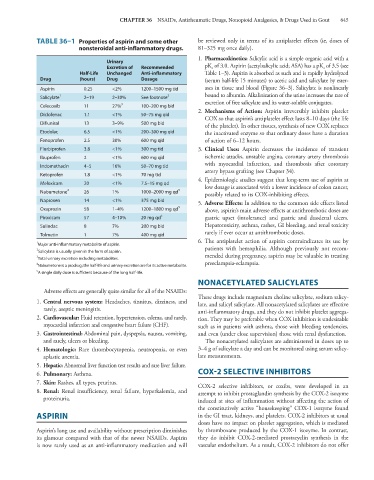Page 659 - Basic _ Clinical Pharmacology ( PDFDrive )
P. 659
CHAPTER 36 NSAIDs, Antirheumatic Drugs, Nonopioid Analgesics, & Drugs Used in Gout 645
TABLE 36–1 Properties of aspirin and some other be reviewed only in terms of its antiplatelet effects (ie, doses of
nonsteroidal anti-inflammatory drugs. 81–325 mg once daily).
1. Pharmacokinetics: Salicylic acid is a simple organic acid with a
Urinary
Excretion of Recommended pK of 3.0. Aspirin (acetylsalicylic acid; ASA) has a pK of 3.5 (see
a
a
Half-Life Unchanged Anti-inflammatory Table 1–3). Aspirin is absorbed as such and is rapidly hydrolyzed
Drug (hours) Drug Dosage (serum half-life 15 minutes) to acetic acid and salicylate by ester-
Aspirin 0.25 <2% 1200–1500 mg tid ases in tissue and blood (Figure 36–3). Salicylate is nonlinearly
Salicylate 1 2–19 2–30% See footnote 2 bound to albumin. Alkalinization of the urine increases the rate of
excretion of free salicylate and its water-soluble conjugates.
Celecoxib 11 27% 3 100–200 mg bid
2. Mechanisms of Action: Aspirin irreversibly inhibits platelet
Diclofenac 1.1 <1% 50–75 mg qid
COX so that aspirin’s antiplatelet effect lasts 8–10 days (the life
Diflunisal 13 3–9% 500 mg bid of the platelet). In other tissues, synthesis of new COX replaces
Etodolac 6.5 <1% 200–300 mg qid the inactivated enzyme so that ordinary doses have a duration
Fenoprofen 2.5 30% 600 mg qid of action of 6–12 hours.
Flurbiprofen 3.8 <1% 300 mg tid 3. Clinical Uses: Aspirin decreases the incidence of transient
Ibuprofen 2 <1% 600 mg qid ischemic attacks, unstable angina, coronary artery thrombosis
with myocardial infarction, and thrombosis after coronary
Indomethacin 4–5 16% 50–70 mg tid
artery bypass grafting (see Chapter 34).
Ketoprofen 1.8 <1% 70 mg tid
4. Epidemiologic studies suggest that long-term use of aspirin at
Meloxicam 20 <1% 7.5–15 mg qd low dosage is associated with a lower incidence of colon cancer,
Nabumetone 4 26 1% 1000–2000 mg qd 5 possibly related to its COX-inhibiting effects.
Naproxen 14 <1% 375 mg bid 5. Adverse Effects: In addition to the common side effects listed
Oxaprozin 58 1–4% 1200–1800 mg qd 5 above, aspirin’s main adverse effects at antithrombotic doses are
Piroxicam 57 4–10% 20 mg qd 5 gastric upset (intolerance) and gastric and duodenal ulcers.
Sulindac 8 7% 200 mg bid Hepatotoxicity, asthma, rashes, GI bleeding, and renal toxicity
rarely if ever occur at antithrombotic doses.
Tolmetin 1 7% 400 mg qid
6. The antiplatelet action of aspirin contraindicates its use by
1
Major anti-inflammatory metabolite of aspirin.
2 Salicylate is usually given in the form of aspirin. patients with hemophilia. Although previously not recom-
3 mended during pregnancy, aspirin may be valuable in treating
Total urinary excretion including metabolites.
4 Nabumetone is a prodrug; the half-life and urinary excretion are for its active metabolite. preeclampsia-eclampsia.
5
A single daily dose is sufficient because of the long half-life.
NONACETYLATED SALICYLATES
Adverse effects are generally quite similar for all of the NSAIDs:
These drugs include magnesium choline salicylate, sodium salicy-
1. Central nervous system: Headaches, tinnitus, dizziness, and late, and salicyl salicylate. All nonacetylated salicylates are effective
rarely, aseptic meningitis. anti-inflammatory drugs, and they do not inhibit platelet aggrega-
2. Cardiovascular: Fluid retention, hypertension, edema, and rarely, tion. They may be preferable when COX inhibition is undesirable
myocardial infarction and congestive heart failure (CHF). such as in patients with asthma, those with bleeding tendencies,
3. Gastrointestinal: Abdominal pain, dyspepsia, nausea, vomiting, and even (under close supervision) those with renal dysfunction.
and rarely, ulcers or bleeding. The nonacetylated salicylates are administered in doses up to
4. Hematologic: Rare thrombocytopenia, neutropenia, or even 3–4 g of salicylate a day and can be monitored using serum salicy-
aplastic anemia. late measurements.
5. Hepatic: Abnormal liver function test results and rare liver failure.
6. Pulmonary: Asthma. COX-2 SELECTIVE INHIBITORS
7. Skin: Rashes, all types, pruritus. COX-2 selective inhibitors, or coxibs, were developed in an
8. Renal: Renal insufficiency, renal failure, hyperkalemia, and attempt to inhibit prostaglandin synthesis by the COX-2 isozyme
proteinuria. induced at sites of inflammation without affecting the action of
the constitutively active “housekeeping” COX-1 isozyme found
ASPIRIN in the GI tract, kidneys, and platelets. COX-2 inhibitors at usual
doses have no impact on platelet aggregation, which is mediated
Aspirin’s long use and availability without prescription diminishes by thromboxane produced by the COX-1 isozyme. In contrast,
its glamour compared with that of the newer NSAIDs. Aspirin they do inhibit COX-2-mediated prostacyclin synthesis in the
is now rarely used as an anti-inflammatory medication and will vascular endothelium. As a result, COX-2 inhibitors do not offer

